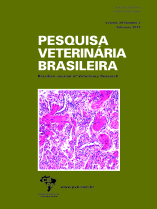 |
|
|
|
Year 2019 - Volume 39, Number 2
|

|
Characterization of ruminal acidosis and initial phase of laminitis inducted by oligofructose in crossbred calves, 39(2):99-106
|
ABSTRACT.- Noronha Filho A.D.F, Freitas S.L.R., Rodrigues D.F., Mendes F.F., Miguel M.P., Cunha P.H.J., Fioravanti M.C.S. & Silva L.A.F. 2019. Characterization of ruminal acidosis and initial phase of lamnitis inducted by oligofructose in crossbred calves. Pesquisa Veterinária Brasileira 39(2):99-106. Escola de Veterinária e Zootecnia, Universidade Federal de Goiás, Campus Samambaia, Avenida Esperança s/n, Goiânia, GO 74690-900, Brazil. E-mail: dionisiofnf@hotmail.com
One of the ways to study cattle laminitis is its experimental induction by supplying a large amount of high fermentation carbohydrate. The most effective protocol until now has been the use of oligofructose. The objective of this study was to evaluate clinical and histological aspects of the hoof in experimental induction of ruminal acidosis and laminitis in calves using oligofructose. Six crossbred (Bos taurus x Bos indicus) yearling calves divided into Group I (GI) and Group II (GII) were used. Animals in GI and GII received intraruminal oligofructose in doses of 13 and 17g/kg, respectively. During 28 hours the calves were clinically evaluated and 30 hours after induction, samples were taken from coronary and abaxial wall of the hoof for histologic evaluation. Were noticed signs of ruminal and metabolic acidosis like rumen distension with fluid, diarrhea, ruminal pH reduction and, at blood gas analysis, pH and bicarbonate below reference range. Lameness was not observed however, some animals had a slower gait and apathy, possibly due to metabolic acidosis, though. Histologically, typical lesions of laminitis like circulatory changes and inflammatory infiltrate in the dermis, irregularities and areas of detachment at basement membrane and morphologic changes in cells from basal epidermis were found. The protocol induced, in the first 30 hours, clinical signs of ruminal and metabolic acidosis and low grade histologic lesions in the digits. Lameness and digit pain were not observed, characterizing the prodromic phase of the disease. |
| |
|
|
| |
|
 |